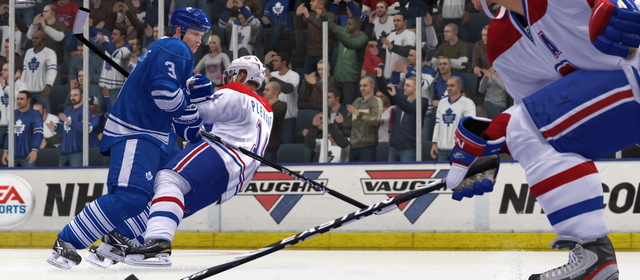Big hits and fights are a big part of Ice Hockey, but in the past the physicality of the sport has never quite been captured perfectly. EA Canada are lloking to change all that with NHL 14, as they have created a whole new collision physics engine for the game.
Polygon got their hands on the latest developer diary from EA, entitled NHL Collision Physics – Delivering the Hits, where we get to take a look at this brand new engine. Not only that, but the developers have also put out a new blog entry, that details many of the changes.
The theory behind the new system is that the team are now considering four main points when thinking about physics: size, speed, momentum and body position. The new game can also now track more than 250 collision points on each body – which can create the most realistic representation of the different forces at work during a collision. Some of this technology has been borrowed from EA Canada’s own FIFA Player Impact Engine.
Some of these new collision features are:
Left-Stick Hitting
A new left-stick control scheme makes delivering a game-changing hit simpler and more rewarding than ever. Right-stick hitting controls remain unchanged, but now players can deliver a big hit with only the left stick simply by skating into their opponents with speed.
Five Gameplay Changes Based on Community Feedback
1. Hip checks are now fully integrated into the physics system
Speed and Momentum Matter – Speed between the two skaters, direction/alignment and player rating attributes (such as hitting and balance) are now better accounted for within NHL® Collision Physics.
Improved Player Facing – Players will now pivot and turn their hip into the direction of the check with greater consistency; ensures that strong hip checks will only occur when a player is in good position.
No more Hip Check Spamming – A successful hip check has to be made with the hip, users must be in good position to throw a great hit. If a user initiates a hip check at the last second without being in good position, you’ll see hits that will only result in glancing contact, or a player stumbling or avoiding the hip check altogether.
2. Improved Goalie Collisions
Goalie Reactions to Contact – Goalies will be live in all areas of the ice and their reactions to contact will be more realistic, utilizing the improved ragdoll physics models used in NHL® Collision Physics.
Goalie Interference – Improved logic to ensure big collisions with the goalie result in penalties and goals as a result of goalie interference are called back more reliably.
3. More Realistic Incidental Contact
Speed and Momentum Matter – Not only will incidental contact occur more frequently, but speed and momentum will determine whether players colliding incidentally will trip and stumble or remain in control. Player balance attributes will also play a role here.
4. Type of Hits Thrown
Player Anticipation – Players will gauge the relative speed between the checker and the person being hit to decide what type of hit to throw.
Shoulder vs. Push Checks – Defenders will use shoulder checks when they are able to anticipate the hit and brace with their shoulder. Defenders will use push checks when they need to generate force because players are moving more slowly.
5. Penalty Calls
Interference – Stricter calls. Players won’t be able to hit players as late after they release the puck.
Boarding/Hitting from Behind – Enhanced penalty logic to judge the appropriate circumstances of a hit (angle, speed and result of the hit) and make the right call based on each situation.
Charging – More logic was added to understand the variables of each hit, such as the speed and line the hitter has taken.
Watch the latest NHL 14 Developer Diary video below:
NHL 14 will be released on September 13 in Europe and September 10 in North America for Xbox 360 and PlayStation 3






